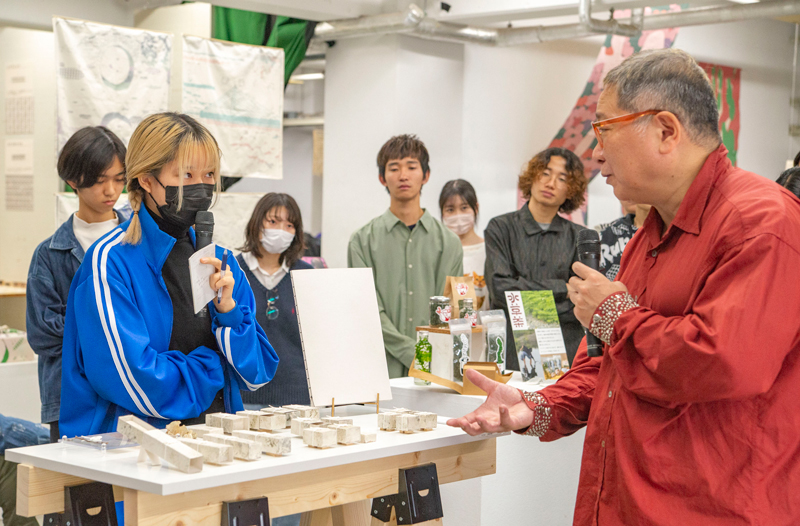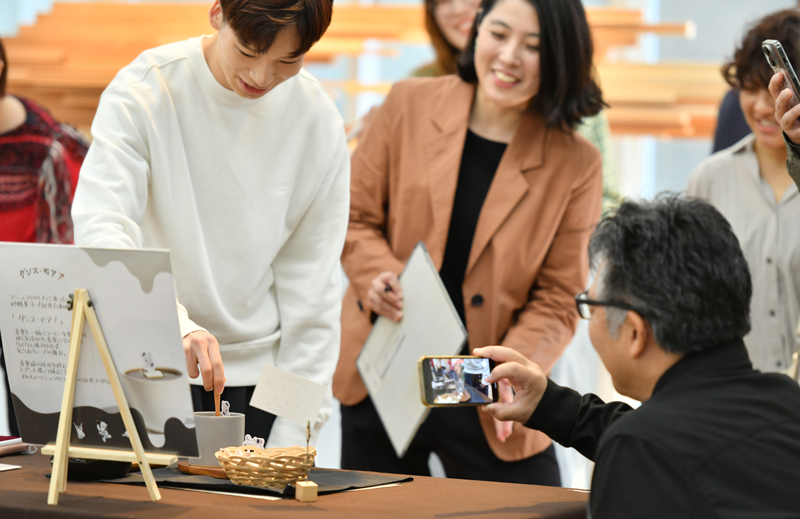DEPARTMENT OF DESIGN
Department/course summary
 Design education at Tokyo University of the Arts began with the Department of Design established in 1896 at the university’s predecessor, the Tokyo Fine Arts School (founded in 1887). For over a century since then, the department has played a continuing and important role as a driving force behind the creation of culture and ways of living suited to the times, amid various changes in social structures, cultural awareness, and production systems.
Design education at Tokyo University of the Arts began with the Department of Design established in 1896 at the university’s predecessor, the Tokyo Fine Arts School (founded in 1887). For over a century since then, the department has played a continuing and important role as a driving force behind the creation of culture and ways of living suited to the times, amid various changes in social structures, cultural awareness, and production systems.
Ever since its foundation in 1896, the department has followed its educational philosophy of pursuing comprehensive education and advanced design capabilities built on tradition and developing a truly creative spirit to serve as a creative force in contemporary society. Based on this philosophy, the department has continued to graduate large numbers of highly qualified designers.
Today, amid cultural diversification and advancing information technology, there is a need for fundamental questions and answers targeting the origins of the ways we live. The department answers such questions based on recognizing anew its educational philosophy of pursuing functionality and beauty in everyday life and respecting both tradition and innovation.
Policy
Curriculum Policy
Faculty: The goal is to nurture creative individuals with a comprehensive vision. Therefore, undergraduate education advances to a higher academic level each year and assumes a systemic form that enables one to gradually work toward a higher degree of specialization beginning from the basic course of design. The curriculum is not bound by the framework of existing specialized domains. Rather, it is organized in a way that the students are allowed to study shared elements of each specialized field, discover their potential, and align themselves to their future goals.
Master: Depending on the research themes, students are provided with separate studios (there are 10 studios); this enables them to conduct specialized research and creative work in their respective studios. While the students’ own research and creative work are the main components of the two-year program, in the first year, through a social collaboration program organized as a shared subject, students can work beyond their research themes and conduct complex and practical research and education. Thus, the curriculum content is structured in such a way so as to lend greater depth to the students’ research themes.
Doctor: Design research comprises a greatly enhanced and in-depth specialization informed by a comprehensive social perspective. The students build their own original design theory and pursue more advanced creative research and creative work over a period of three years. Each year the students enthusiastically participate in research activities, such as international exchange and social collaboration programs, planned by the department and the studios, thus broadening the scope of their research. The adopted research guidance program is designed to be useful in gaining practical experience.
Diploma Policy
Faculty: The Bachelor’s degree is awarded once the undergraduate curriculum policy is fulfilled and the final year of graduation work has been thoroughly assessed.
Master: The Master’s degree is awarded once the Master’s curriculum policy is fulfilled and the Thesis Review Committee comprising of a supervisor and several teaching staff from related fields of study has thoroughly assessed the completed work.
Doctor: The doctoral degree is awarded once the doctor curriculum policy has been fulfilled and once the Thesis Review Committee comprising all teachers within the department and a panel of examiners from outside the Department has conducted a thorough assessment of the creative work and has reviewed the dissertation.
Curriculum
Educational and research structure
The Design program keeps our class numbers small to promote interaction among students and faculty. Our BA program consists of 45 students per year. Practical exercises, technical training, and lectures are conducted by full-time faculty and by part-time lecturers who are active and prominent in their fields. Our approach is designed to help students develop their talents freely, without being restricted by existing genres, while progressively accumulating specialized techniques and wisdoms. Our unique curriculum gives students the time and space to determine their strengths and discover what they want to pursue.
Curriculum (undergraduate education)
To develop creators with comprehensive, integrated points of view, the undergraduate curriculum is designed to allow students to discover their own possibilities and choose courses through shared learning in each specialized topic, unconfined to existing domains.
This system lets students advance toward specialization by studying topics under all 10 themes of study in the first and second years of the program and choosing from the themes of visual, spatial, and functional design research as they advance through the curriculum. Specialized and intensive lectures are assigned as appropriate, with consideration given to the unification of design creation and expert knowledge. Student thesis projects are handled under a system whereby each studio provides individualized guidance to heighten the quality of the work.
*First year
Design fundamentals course: observation and expression
Students will develop basic design skills, starting with sketching and modeling. The assignments, which involve surveying, thinking about functionality, observation, and exploring the possibilities of materials, will widen students’ perspectives and provide a solid foundation for their future creative work.
*Second year
Specialized fundamentals course: inspiration and expression
Students are given five assignments designed to develop their creative thinking skills and expressive abilities. Through these assignments, along with elective technical training sessions and lectures that provoke thought on the meaning of design, students will gradually discover their strengths and what they want to pursue.
*Third year
Specialized courses: conception and expression
Students will develop their conceptual thinking skills, ability to pose questions, problem-solving skills, and ability to communicate ideas, through assignments inquiring into contemporary social problems and future lifestyles. Highly specialized electives are available to help students narrow down their future path. Students will visit Kyoto and Nara for a mandatory 10-day research trip to learn about classical art and culture.
*Fourth year
Specialized courses: design and expression; thesis project
Students will choose a theme for their graduation project and spend the year working on it. Advising for the projects is provided by all 10 studio professors. Four or five students are assigned to each studio, although the program is open and students are free to visit any professor as required.
Curriculum (graduate education and research)
In the graduate program, three to five students join each studio after completing the undergraduate program and pursue their research and creative work more deeply under the guidance of their advisors. Through active participation in societal collaboration and interdisciplinary projects with students from outside the design programs, students learn how to connect their fields of expertise to other disciplines. The graduate program also encourages students to take advantage of the study abroad program to enrich their experiences of collaboration within different cultural settings.
Doctoral programs focus on design research with more in-depth specialization from a comprehensive perspective. In addition to studying his or her own original design theory, each student also pursues more advanced creative research and creative work. Participating proactively in research activities such as social-involvement activities and international exchange planned by the department and studios, students broaden the scope of their studies and gain practical experience.





